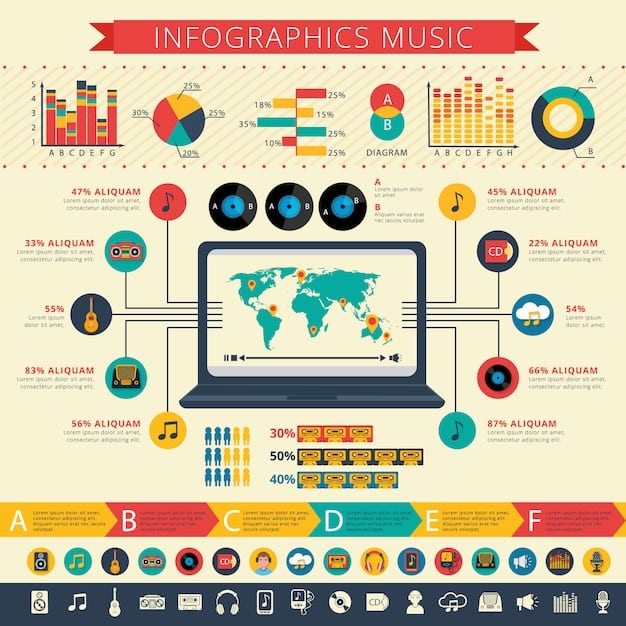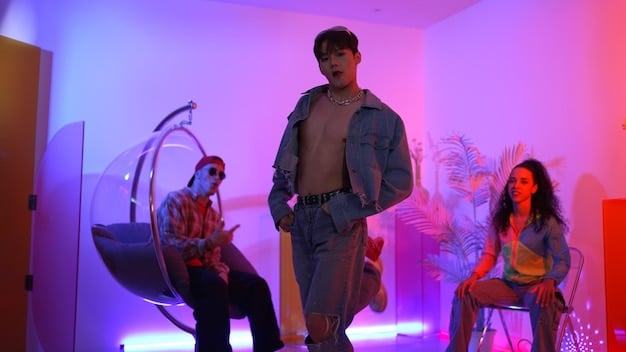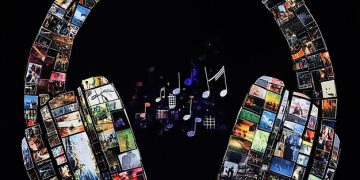How Streaming Services Reshaped Pop Music Royalties by 2025

By 2025, streaming services have fundamentally altered pop music royalties, shifting revenue distribution from traditional sales models to complex, data-driven payout structures that increasingly favor major labels and established artists, while challenging emerging creators to adapt to new monetization paradigms and fan engagement strategies.
The dawn of the digital age brought with it a revolution in how we consume music, shifting from physical ownership to on-demand access. But as listeners embraced this convenience, a fundamental question emerged: how did streaming services change pop music royalties in 2025? This evolution isn’t just about listening habits; it’s a dramatic reshaping of the financial landscape for artists, songwriters, and the entire music industry, fundamentally altering how creators are compensated.
The Dawn of a New Era: From Sales to Streams
The transition from physical album sales and digital downloads to streaming platforms marked a monumental shift in the music industry’s economic model. For decades, artists earned royalties primarily through per-unit sales, a relatively straightforward system. However, streaming introduced a paradigm where ownership was replaced by access, and revenue generation became a complex web of algorithms, fractional payments, and intricate licensing agreements.
By 2025, this evolution had fully matured, making the traditional models almost unrecognizable. The sheer volume of content available, coupled with the low per-stream payouts, meant that artists needed to generate billions of plays to achieve income levels comparable to past eras of robust album sales. This put immense pressure on emerging artists to gain traction, while established stars leveraged their existing fan bases to accumulate streams.
Understanding the Initial Shift in Royalty Structures
In the early days of streaming, many artists and songwriters felt the pinch. The royalty rates offered by platforms like Spotify, Apple Music, and Amazon Music were often a fraction of what they received from physical sales. This led to widespread debate and calls for greater transparency and fairer compensation. The industry grappled with how to accurately value a “stream” when it didn’t equate to ownership.
The core of the problem lay in how streaming services generated revenue: primarily through subscriptions and ad sales. This income was then distributed to rights holders (record labels, publishers, and distributors) based on complex formulas that often prioritized market share rather than individual artist performance. This system often left independent artists at a distinct disadvantage.
- Per-Stream Payouts: Micro-payments for each listen, often fractions of a cent.
- Pro-Rata System: Revenues pooled and then distributed based on an artist’s share of total streams.
- Subscription vs. Ad-Supported: Different payment tiers and rates for premium and free accounts.
- Licensing Complexity: Royalties divided between master recording owners and publishing rights holders.
By 2025, while the fundamental pro-rata model largely persisted, there were growing discussions and some initial movements towards more artist-centric payment systems. Independent artists, empowered by direct distribution channels, were able to negotiate better deals for themselves, though the overall leverage remained with the major labels.
This foundational shift profoundly impacted revenue streams, forcing artists to diversify their income beyond just recordings, embracing touring, merchandise, and brand partnerships with renewed vigor. The digital landscape demanded not just musical talent but also entrepreneurial acumen.
The Dominance of Aggregators and Labels in 2025
By 2025, the relationship between streaming services, record labels, and independent artists had solidified, with aggregators playing a pivotal role. Major record labels, with their vast catalogs and negotiating power, continued to secure more favorable agreements with streaming platforms, often including advances and minimum guarantees that were unavailable to smaller entities. This created a two-tiered system where the bulk of the revenue flowed to the industry’s giants.
Independent artists increasingly relied on digital distributors or aggregators to get their music onto these platforms. While these services democratized access, allowing anyone to upload and share music globally, they also introduced new costs and fees. Artists often paid a flat fee or a percentage of their royalties to these aggregators, further diminishing their per-stream earnings. The promise of direct artist-to-fan monetization remained a powerful ideal, but the practicalities of scale and distribution often necessitated intermediaries.
The Rise of “Artist-Centric” Models and Their Limitations
In response to persistent artist complaints, some streaming platforms, or at least industry pundits, began advocating for “artist-centric” payment models by 2025. These proposals aimed to pay artists based on who genuinely engaged their direct listeners, rather than simply on their overall market share of streams. The idea was to prevent accidental plays or fraudulent streams from diluting the value of genuine fan engagement. However, implementing such a radical shift proved incredibly challenging, facing resistance from established industry players who benefited from the existing pro-rata system.
While some platforms experimented with partial artist-centric features, a full overhaul of the system remained elusive. The sheer complexity of tracking genuine engagement, distinguishing it from passive listening, and fairly allocating revenue across millions of artists and billions of streams, presented significant logistical hurdles. Moreover, the economic implications for platforms themselves, who feared disrupting their delicate financial balance with major labels, meant that any large-scale change was slow to materialize, creating a sense of frustration among many creators.
- Major Label Leverage: Continually securing preferential deals and market share.
- Aggregators’ Role: Essential for independent artists but often come with fees/commissions.
- Artist-Centric Debates: Proposals to pay artists based on direct listener engagement, not just total streams.
- Technological Hurdles: The difficulty in implementing and scaling new royalty distribution models.
Ultimately, the structure of 2025 still largely favored the existing power dynamics, where artists with significant backing or a colossal fan base could navigate the streaming landscape more successfully. For the vast majority, the challenge was not just creating music but developing sustainable business models around fiercely competitive digital revenue streams.
The Impact on Pop Music Production and Strategy
The nuanced royalty structures of streaming services by 2025 had a profound, often subtle, influence on pop music production and release strategies. Artists and labels, acutely aware of the “per-stream” economics, began optimizing their creative output for maximum streamability. This meant a greater emphasis on shorter, catchier tracks, designed to hook listeners quickly and encourage repeat plays. The “intro-verse-chorus” formula became even more prevalent, with long instrumental breaks or experimental structures often falling by the wayside in favor of immediate gratification.
Moreover, the concept of a “lean-back” listening experience, where curated playlists dominated, encouraged the production of music that fit seamlessly into various moods and genres. Artists weren’t just creating songs; they were creating audio assets for specific playlist niches. This led to a more strategic, data-driven approach to music-making, where analytics on listen-through rates, skips, and repeat plays heavily informed subsequent creative decisions, sometimes at the expense of artistic freedom or conceptual album arcs.
The Rise of Playlist Curators and Influencer Marketing
By 2025, playlisting was less a promotional tool and more a primary distribution channel. Being featured on a highly followed official Spotify playlist or an influential independent curator’s list could make or break an emerging pop artist. This power shift created a new ecosystem of gatekeepers, distinct from traditional radio programmers. Labels and artists heavily invested in fostering relationships with these curators, often employing specialized teams to pitch and promote their music for playlist inclusion.
Beyond traditional playlists, social media platforms and their influencers became integral to a pop single’s success. A viral snippet on TikTok or a dance challenge on Instagram could generate millions of streams overnight, effectively bypassing traditional marketing funnels. Royalties gained from these surge streams were still subject to the same payout rates, but the sheer volume made them invaluable. This necessitated a continuous creative feedback loop, where artists crafted tracks not just for listening, but for “sharing” and “trending” across various digital ecosystems, further blurring the lines between music, marketing, and user-generated content.
- Optimized for Streamability: Shorter, catchier tracks prioritized for repeat listens.
- Playlist Dominance: Curators became key gatekeepers, influencing discovery and reach.
- Influencer Marketing: TikTok, Instagram, and other social media platforms driving massive stream volumes.
- Data-Driven Decisions: Analytics heavily informing song structure, release timing, and promotional efforts.
The music industry of 2025 was therefore a highly strategic environment, where understanding data, leveraging digital trends, and mastering the art of algorithmic discovery were as crucial as songwriting talent itself. This fusion of art and analytics reshaped the very sound and presentation of pop music.
The Complexities of Publishing Royalties for Songwriters in 2025
While much of the discussion around streaming royalties focuses on the master recording, the situation for songwriters and music publishers by 2025 remained particularly intricate and often undervalued. Songwriters earn publishing royalties for the composition itself, separate from the master recording owned by the artist or label. These royalties are further divided into mechanical, public performance, and synchronization royalties, each with distinct collection societies and payment mechanisms, making the system notoriously complex.
Streaming services pay mechanical royalties for reproduction and distribution of a copyrighted song, and performance royalties for its public broadcast. By 2025, disputes over these rates were still common, with songwriters and their advocates arguing for a larger share. The digital age, with its global reach and instant accessibility, exposed gaps in the existing legal frameworks, which were often designed for a pre-digital world. Legislative efforts, like the Music Modernization Act in the US, aimed to streamline some of these processes and ensure fairer compensation, but full implementation and universal adoption were ongoing challenges.
The Global Challenge of Royalty Collection and Distribution
The global nature of streaming amplified the challenges in collecting and distributing publishing royalties. A song streamed in Germany by a listener from Japan, featuring a writer from the US and a co-writer from the UK, meant navigating a labyrinth of international collection societies, territorial licenses, and varying legal interpretations. By 2025, technological solutions, such as blockchain-based tracking systems, were being explored to bring greater transparency and efficiency to this process, but widespread adoption was still in its early stages.
Moreover, the rise of user-generated content (UGC) platforms, where users themselves incorporate copyrighted music into their videos, presented another layer of complexity. While these platforms provided immense promotional value, ensuring that songwriters received proper attribution and compensation for millions of informal uses remained a significant hurdle. Many platforms were still negotiating blanket licenses, rather than individually tracking and paying for each usage, often leading to underpayment or delayed payment for songwriters. The digital age, for all its connectivity, brought with it a new set of administrative and financial headaches for the original creators of the music.
- Mechanical Royalties: Payments for the reproduction of a song (e.g., streaming).
- Performance Royalties: Payments for public broadcasts of a song (e.g., streaming).
- Complex Global Network: Navigating various collection societies and international laws.
- User-Generated Content (UGC): Challenges in tracking and compensating for music used in user videos.
Consequently, songwriters in 2025 faced an even greater need for skilled administrative support, robust publisher representation, and legal advocacy to ensure they received their due in a landscape that was both global and fragmented, often leaving them in a financially vulnerable position compared to the performers of their tracks.

Equity and Fair Compensation Debates in 2025
By 2025, the debate surrounding equitable compensation for artists on streaming platforms had reached a fever pitch. While early optimism focused on democratizing music, the reality was that the lion’s share of streaming revenue continued to flow to a small percentage of mega-hits and established artists, alongside the major labels and streaming platforms themselves. This left a vast stratum of mid-tier and emerging artists struggling to earn a living wage solely from streaming royalties.
Artist advocacy groups, musician unions, and independent artist collectives continued to push for reforms. Their demands included higher per-stream payout rates, greater transparency in how royalties are calculated and distributed, and a shift away from the pro-rata model towards more user-centric payment systems. The argument was that if a listener primarily streamed one artist, that artist should receive a larger share of the listener’s subscription fee, rather than having it pooled into a general pot where it could trickle down to artists the listener never engaged with. This remained a contentious issue, balancing the interests of all stakeholders.
The Role of Data Transparency and Artist Empowerment
A significant aspect of the fair compensation debate in 2025 revolved around data transparency. Artists and their representatives often found it challenging to get clear, granular data on how their streams translated into actual income. Streaming platforms, citing proprietary algorithms and competitive concerns, often provided aggregate data, making it difficult for artists to audit their earnings effectively. This lack of transparency fueled distrust and made it harder to negotiate for better terms.
However, alongside these challenges, 2025 also saw advances in artist empowerment tools. Companies emerged offering analytics dashboards that helped artists understand their audience better, identify geographic strongholds, and optimize their release strategies. Direct-to-fan platforms also gained traction, allowing artists to sell merchandise, exclusive content, and experiences directly to their most dedicated followers, bypassing some of the traditional intermediaries. While not a direct solution to royalty issues, these tools provided artists with alternative revenue streams and greater control over their careers, allowing them to build more resilient economic foundations even within the imperfect streaming ecosystem.
- Persistent Inequality: Majority of revenue still concentrated among top artists and labels.
- Advocacy for Reforms: Calls for higher rates, transparency, and user-centric payment models.
- Data Opacity: Challenges for artists to access granular data on their earnings.
- Empowerment Tools: Analytics dashboards and direct-to-fan platforms offering alternative revenue and insights.
The conversation around equity in 2025 was less about overturning the streaming model entirely, and more about refining it to be more inclusive and artist-friendly. It represented a collective struggle to balance technological innovation with artistic sustainability, defining what a “fair share” truly means in the digital age.
Diversification of Artist Income Streams by 2025
As the complexities of pop music royalties on streaming services became clearer by 2025, artists increasingly understood the imperative to diversify their income. Relying solely on per-stream payouts became an unsustainable model for most, propelling a strategic pivot towards multiple revenue streams. This wasn’t merely a supplementary effort; for many artists, it became the foundation of their financial viability, often surpassing streaming earnings.
Touring and live performances remained a cornerstone, offering direct fan engagement and significant revenue from ticket and merchandise sales. However, the scope of diversification expanded considerably. Artists invested more time in developing unique merchandise lines, creating exclusive content for fan subscription platforms like Patreon, and forging brand partnerships that aligned with their artistic identity. This multi-faceted approach mirrored entrepreneurial strategies seen in other creative industries, requiring artists to think not just as musicians, but as small business owners.
The Rise of Web3 and Creator Economies
By 2025, the burgeoning fields of Web3 and the creator economy began to offer exciting, albeit nascent, possibilities for artists to reclaim more direct ownership and revenue. Non-Fungible Tokens (NFTs) evolved beyond speculative art pieces, becoming tools for fan engagement and direct monetization. Artists launched NFT collections that offered exclusive access to music, behind-the-scenes content, meet-and-greets, or even fractional ownership in future royalties, forging deeper connections with their most dedicated fans.
Decentralized Autonomous Organizations (DAOs) also emerged as a means for artists and their communities to collectively fund, create, and distribute music, theoretically bypassing traditional labels and streaming gatekeepers. While these technologies were still maturing and faced significant adoption hurdles, they represented a philosophical shift towards empowering creators with direct control over their work and its value. This wasn’t about replacing streaming entirely, but rather creating parallel economies where artists could experiment with new models of ownership, patronage, and distribution, moving beyond the fractional payments of traditional streaming platforms.
- Beyond Streaming: Strong emphasis on touring, merchandise, and direct fan engagement.
- Brand Partnerships: Collaborations becoming a significant income driver.
- NFTs for Fan Engagement: Offering exclusive content and experiences to dedicated fans.
- Web3 and DAOs: Exploring decentralized models for music funding, creation, and distribution.
The landscape of 2025 thus challenged artists to become innovators not just in music, but in business. The artists who thrived were those who embraced these diverse income streams and actively explored new technologies to build resilient and sustainable careers, rather than solely relying on the ever-fluctuating P&L statements from streaming services.

The Future Outlook: Predictions Beyond 2025
Looking beyond 2025, the trajectory of pop music royalties suggests a continued evolution, driven by technological advancements, evolving fan behaviors, and persistent industry debates. While the pro-rata model of streaming will likely remain dominant for the foreseeable future due to its entrenched nature, pressures for more equitable distribution are expected to intensify. This could lead to hybrid models, where elements of user-centric payments are integrated, at least for a portion of the royalties, giving loyal fans’ listening habits a more direct impact on artist earnings.
Technological innovations, particularly in AI and blockchain, are set to play a more significant role. AI tools might streamline rights management and royalty accounting, providing greater transparency and efficiency. Blockchain, while still in its nascent stages for widespread music industry adoption, has the potential to create immutable records of ownership and usage, ensuring faster and more accurate payments to all rights holders, especially in the complex world of publishing and international licensing. The dream of “smart contracts” automating royalty splits directly to artists and songwriters could become a more tangible reality.
The Evolving Relationship Between Artists, Platforms, and Fans
The relationship between artists, platforms, and fans is also poised for further transformation. Platforms will likely continue to invest in features that foster deeper artist-fan connections, recognizing that engaged communities translate into sustained subscriptions and consumption. This could include more personalized content, interactive experiences, and direct communication channels within the streaming apps themselves, evolving beyond simple music playback.
Artists, in turn, will become even more sophisticated marketers and entrepreneurs. The emphasis on building personal brands, cultivating niche communities, and leveraging direct-to-fan models will only grow. The distinction between a “pop star” and a “creative entrepreneur” will blur further, with success predicated not just on hit songs, but on savvy business acumen and an intimate understanding of digital ecosystems. The music industry of tomorrow will be a dynamic ecosystem, constantly adapting to new technologies and new ways of connecting artists with their global audience, while continuously grappling with the fundamental question of fair compensation for creativity.
- Hybrid Royalty Models: Potential integration of user-centric elements within pro-rata systems.
- AI and Blockchain: Streamlining rights management, tracing usage, and automating payments.
- Enhanced Fan Engagement: Platforms investing in personalized content and interactive artist-fan experiences.
- Artist as Entrepreneur: Increased focus on personal branding, niche communities, and direct-to-fan sales.
Ultimately, 2025 serves as a crucial midpoint in this ongoing digital evolution. The changes we observe now are not just temporary shifts but foundational reconfigurations of an industry still learning to navigate the vast, interconnected world of digital music distribution and monetization.
| Key Point | Brief Description |
|---|---|
| 🎶 Royalty Shift | Transitioned from sales to complex, micro-payment streaming models favoring major players. |
| 📈 Aggregator Dominance | Major labels and aggregators retain significant power, often at indie artists’ expense. |
| 💡 Production Impact | Pop music optimized for streamability, leading to shorter, catchier tracks; playlisting crucial. |
| 💰 Diversified Income | Artists rely more on touring, merch, brand deals, and Web3 (NFTs, DAOs) for sustainability. |
Frequently Asked Questions About Streaming Royalties in 2025
By 2025, the primary change is a complete shift from a per-unit sales model to a complex, fractional per-stream payment system. This has dramatically lowered per-song income for most artists, necessitating billions of streams to achieve significant earnings and strengthening the financial position of major labels in royalty negotiations.
While discussions and some experimental features for “artist-centric” payment models gained traction by 2025, widespread adoption remained limited. The complexity, resistance from established players, and the challenge of overhauling deeply embedded pro-rata systems meant that full implementation across major platforms was still an ongoing debate rather than a dominant reality.
Pop music production has adapted significantly by 2025, favoring shorter, catchier tracks optimized for repeat plays and playlist inclusion. Analytics heavily influence creative decisions, with artists often crafting songs designed for rapid engagement and viral potential across platforms like TikTok, sometimes prioritizing streamability over traditional album concepts.
Songwriters face significant challenges by 2025, including lower mechanical and performance royalty rates compared to master recordings, alongside immense complexity in global collection and distribution. The rise of user-generated content further complicates matters, making it hard to track and ensure fair compensation for every use of their compositions.
Beyond streaming, pop artists in 2025 are heavily diversifying income through touring, merchandise, brand partnerships, and direct-to-fan platforms like Patreon. There’s also growing exploration of Web3 technologies, including NFTs for exclusive content and community building, and DAOs for decentralized music funding and distribution, aiming for greater autonomy and direct fan engagement.
Conclusion
The journey of pop music royalties through the streaming era leading up to 2025 has been nothing short of transformative. It transitioned from a clear-cut transaction system to an intricate, algorithm-driven landscape where every stream contributes a fraction of a cent. While streaming platforms have democratized access to music on an unprecedented scale, the financial implications for artists, particularly independent ones, have been complex and often challenging. The established players, like major labels and aggregators, largely retained their power, navigating the nuanced payout models with greater leverage. This environment compelled artists to strategically adapt their creative output for streamability, prioritize playlist inclusion, and harness the power of social media for virality and promotion. For songwriters, the global and fragmented nature of publishing royalties continued to present significant hurdles in ensuring fair compensation. Looking ahead, the industry is poised for further evolution, with ongoing debates about equity, the potential integration of user-centric payment models, and the disruptive promise of Web3 technologies. Ultimately, 2025 stands as a critical juncture, highlighting an industry in constant flux, where innovation in technology and business models remains paramount for artistic sustainability and fair value creation in the digital age of music.





